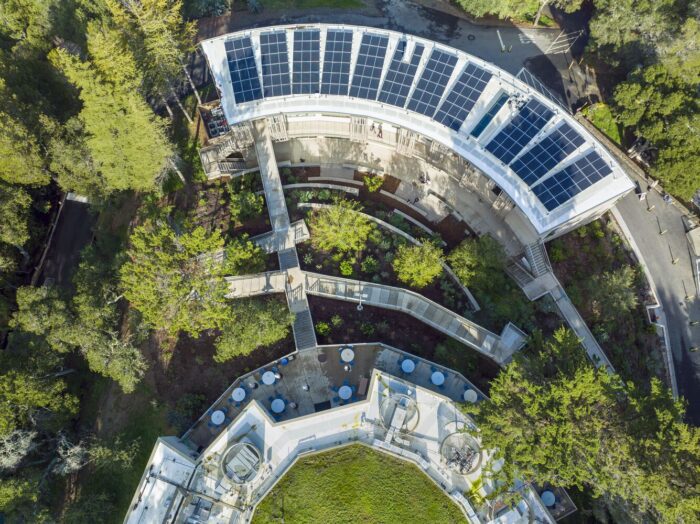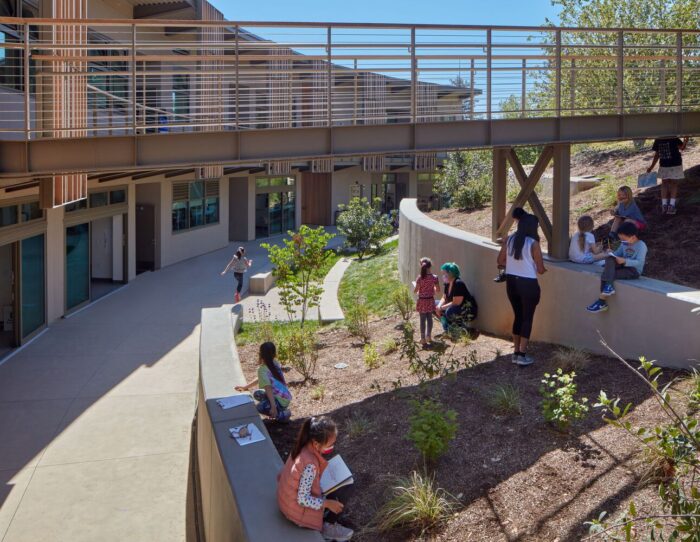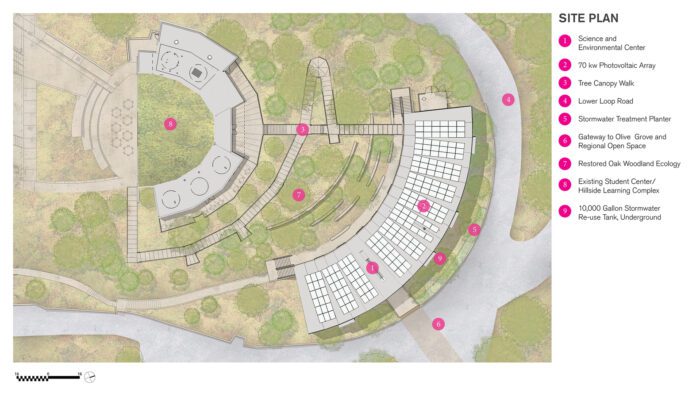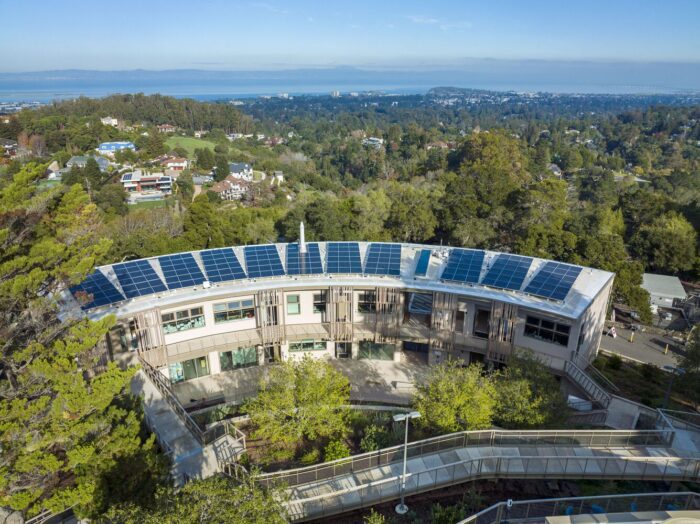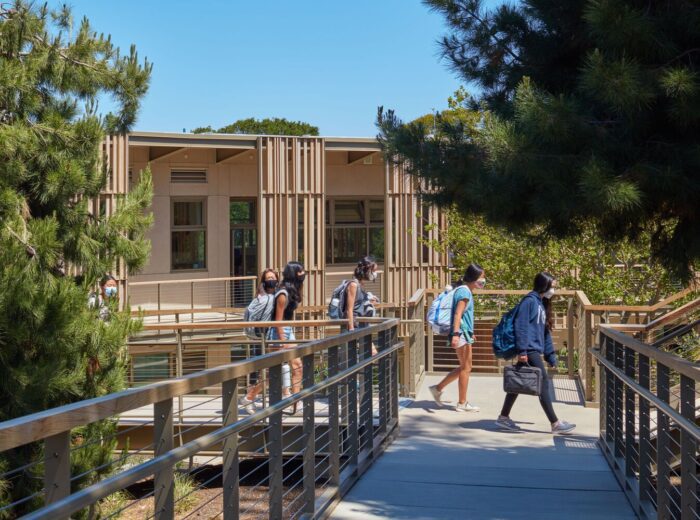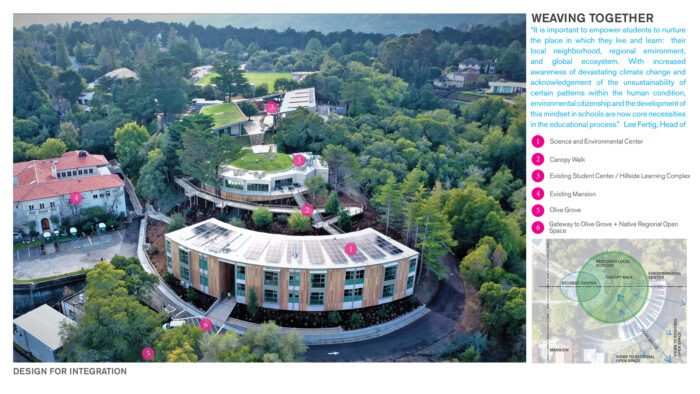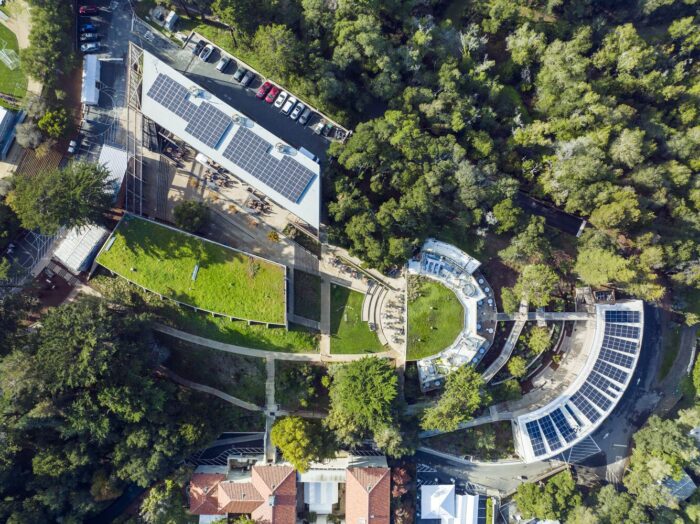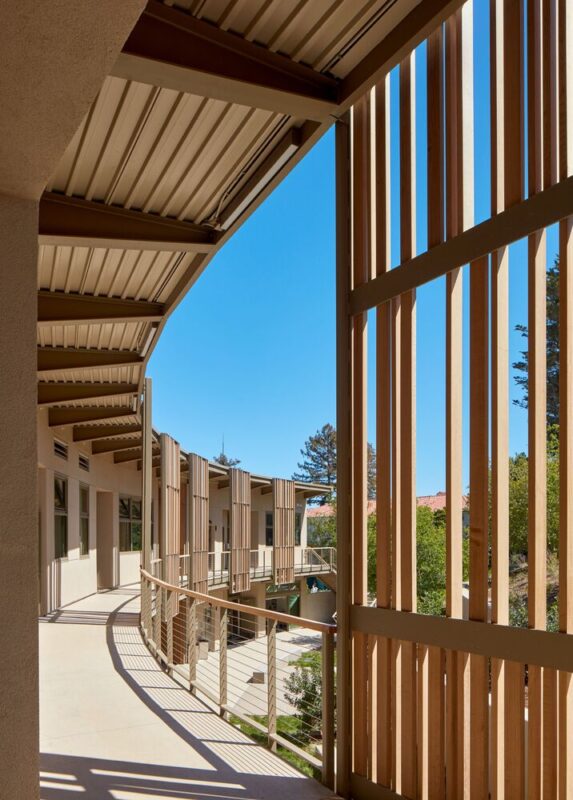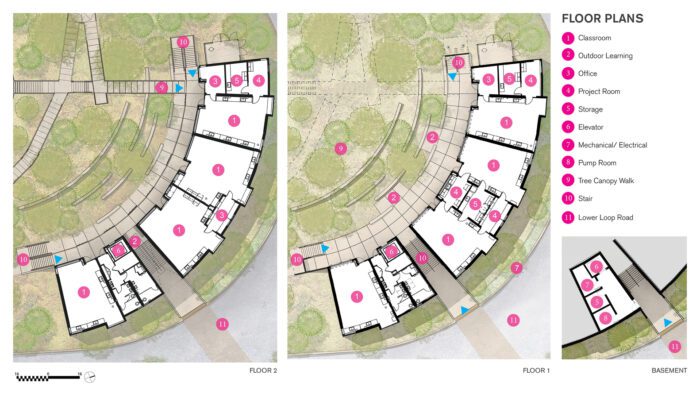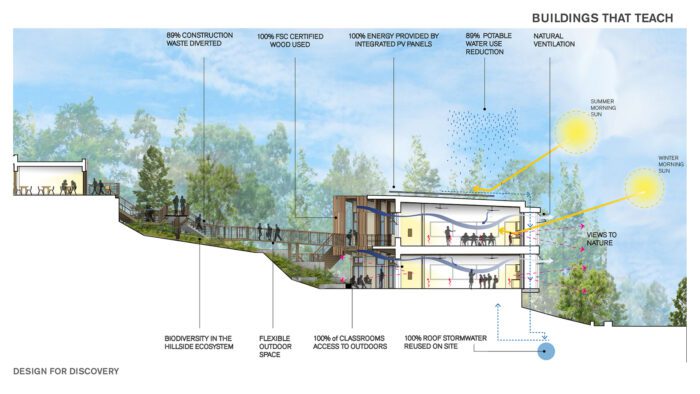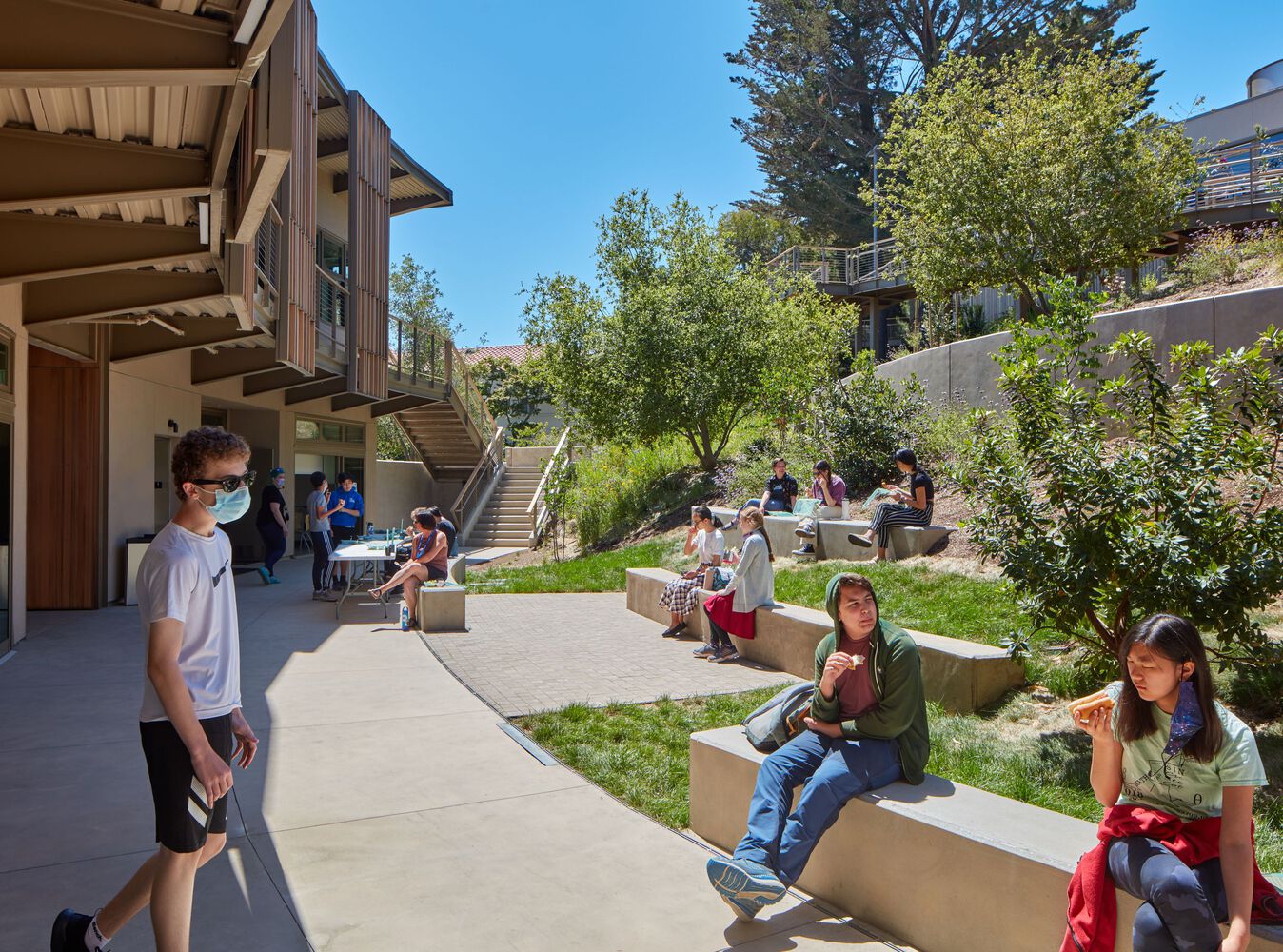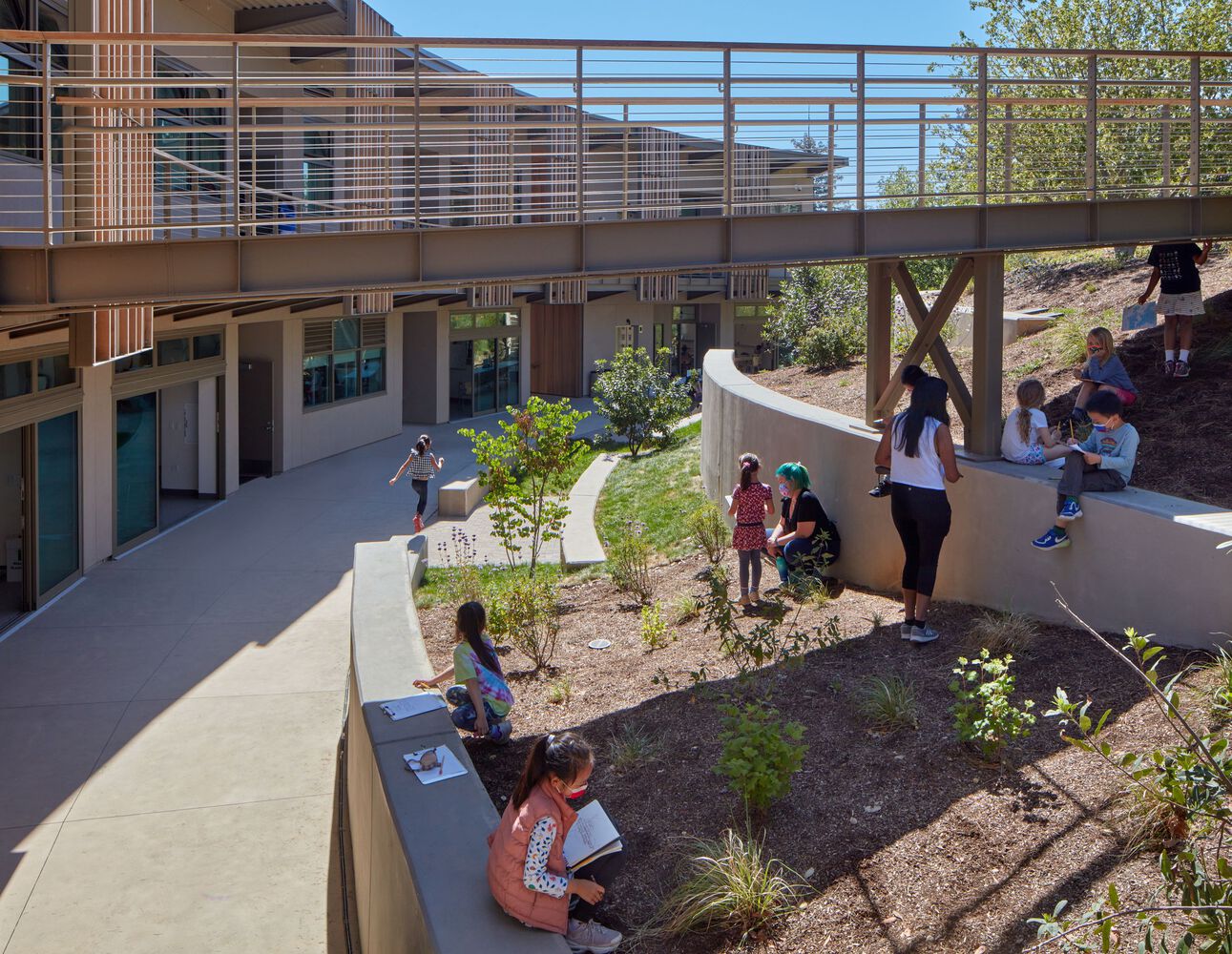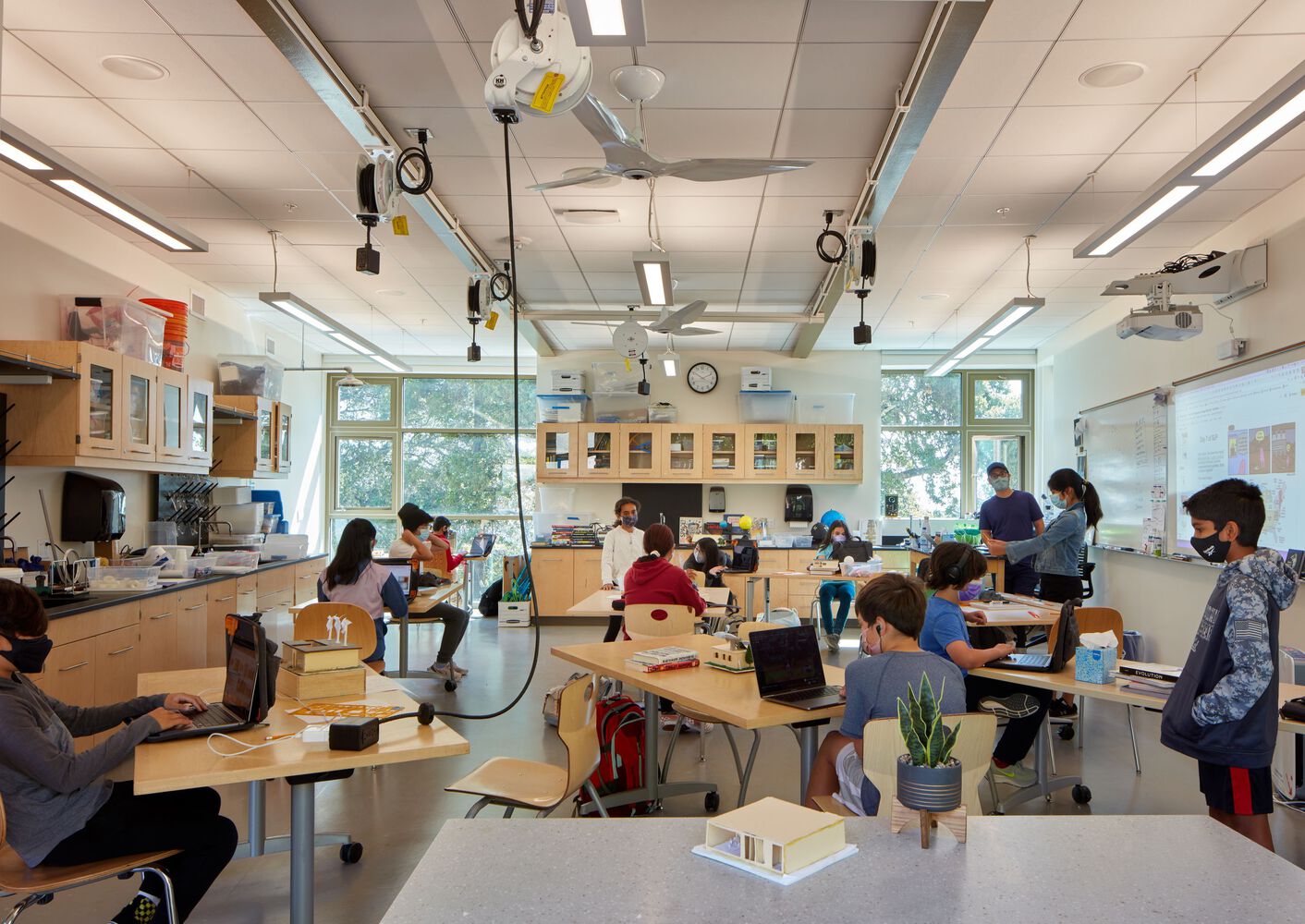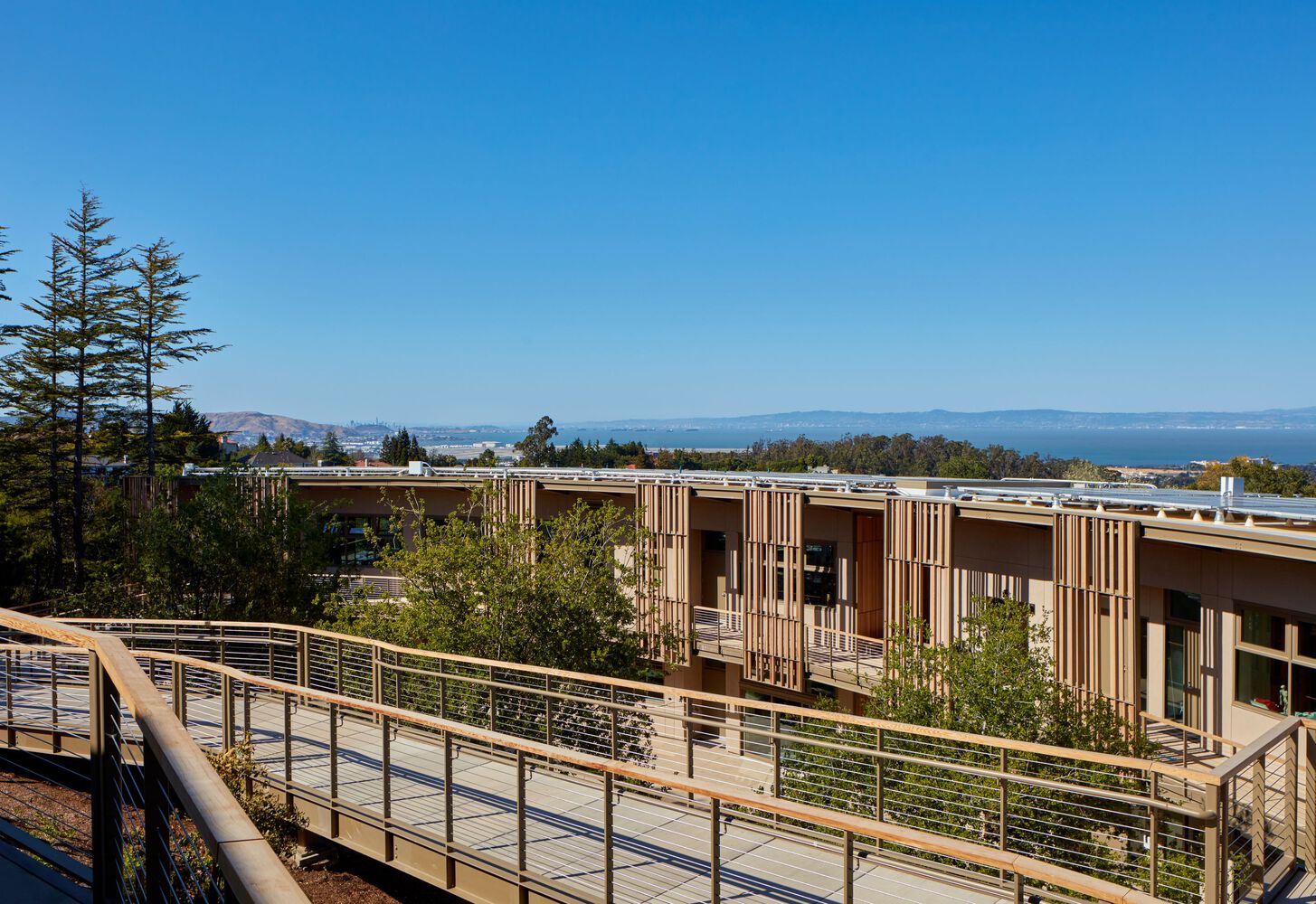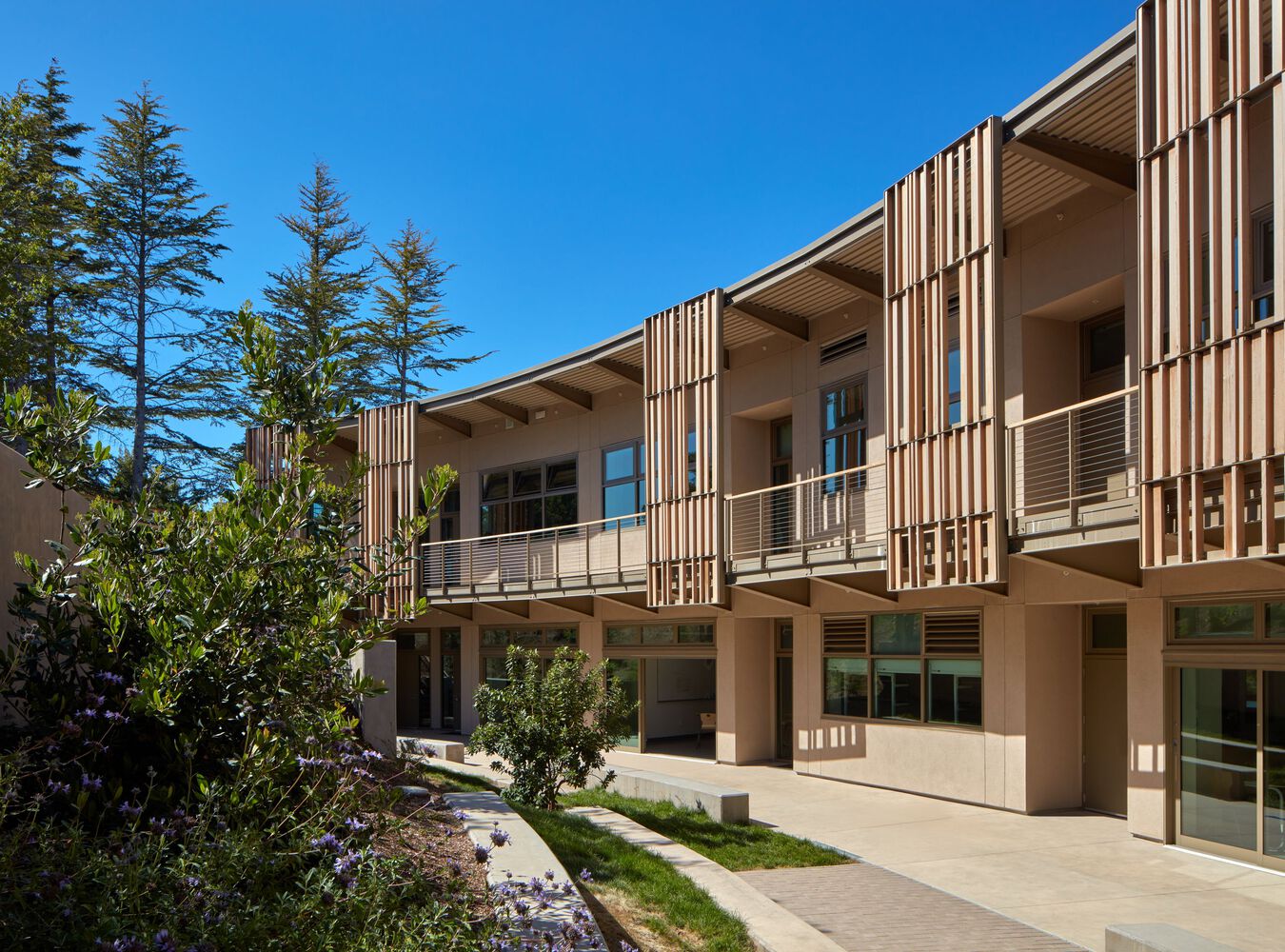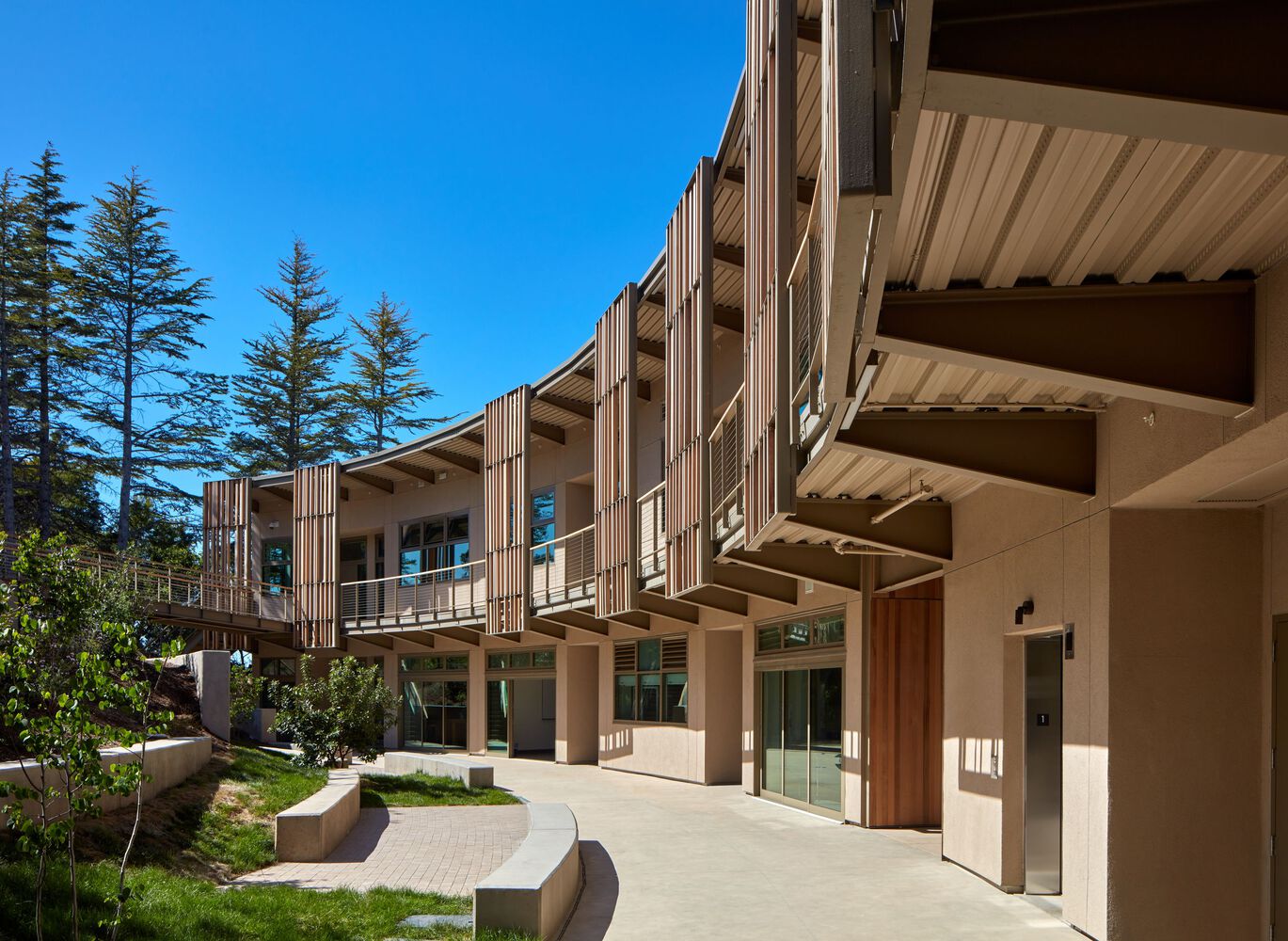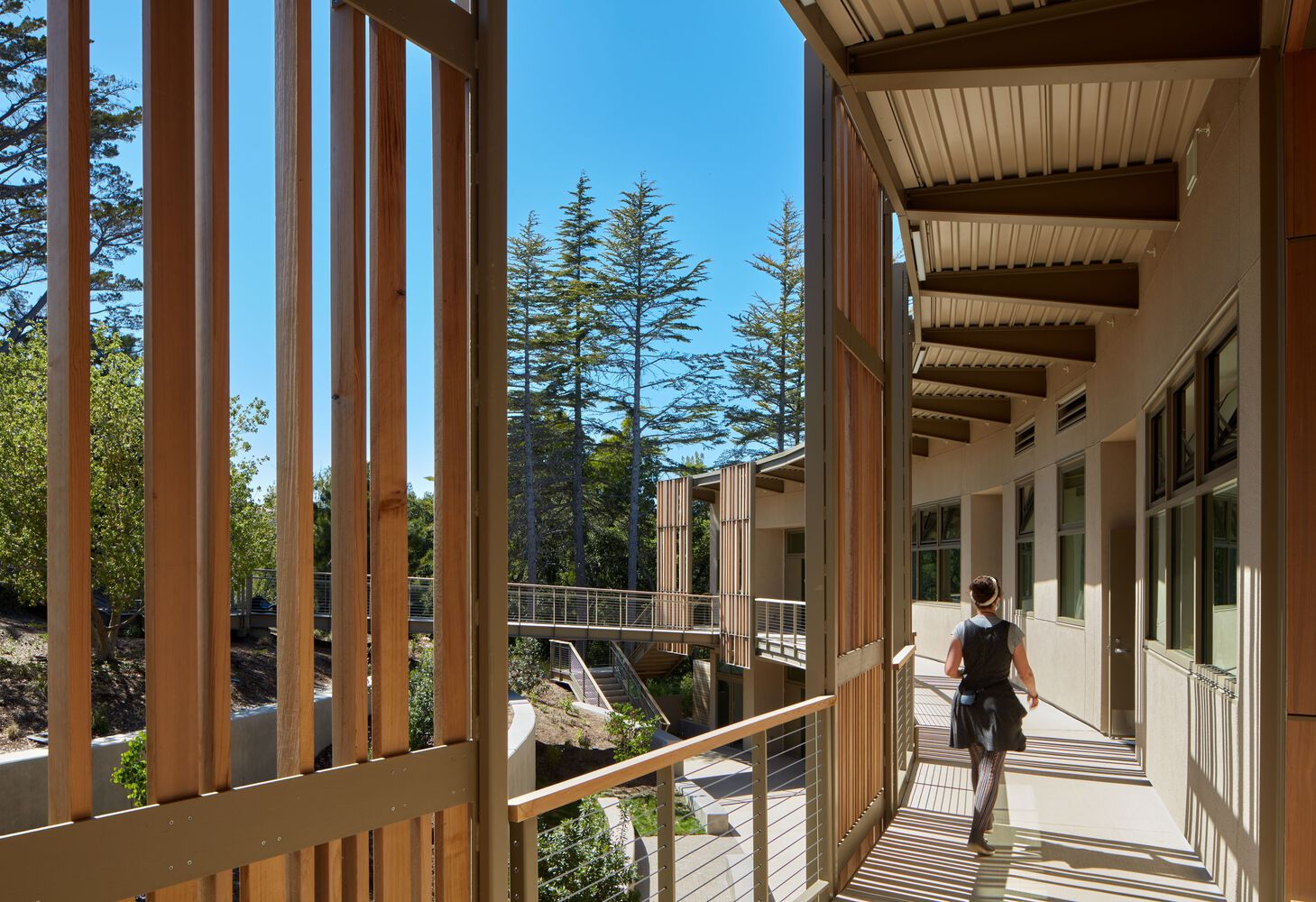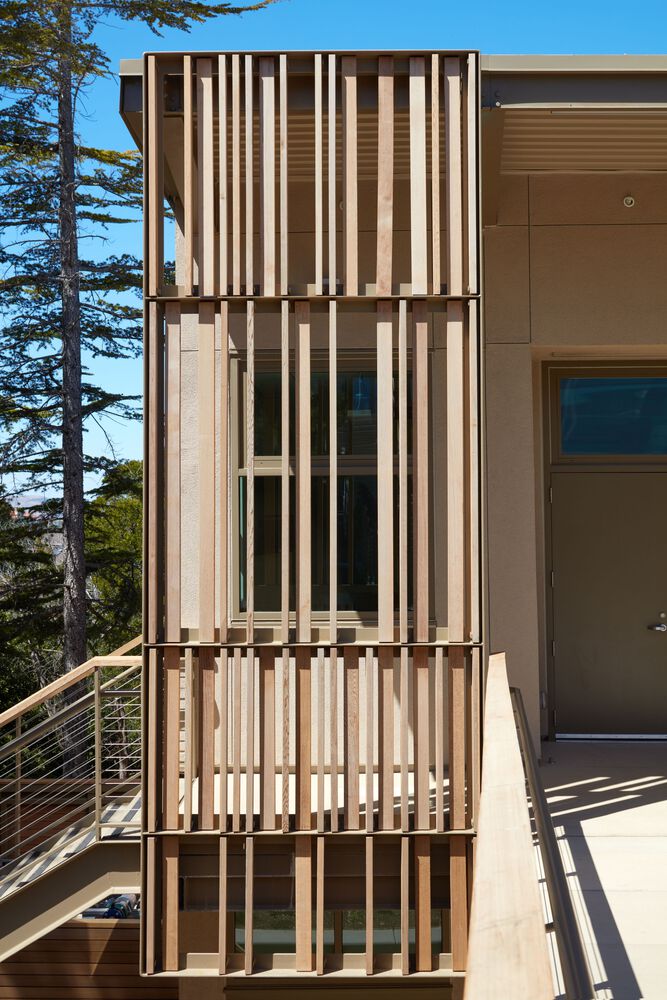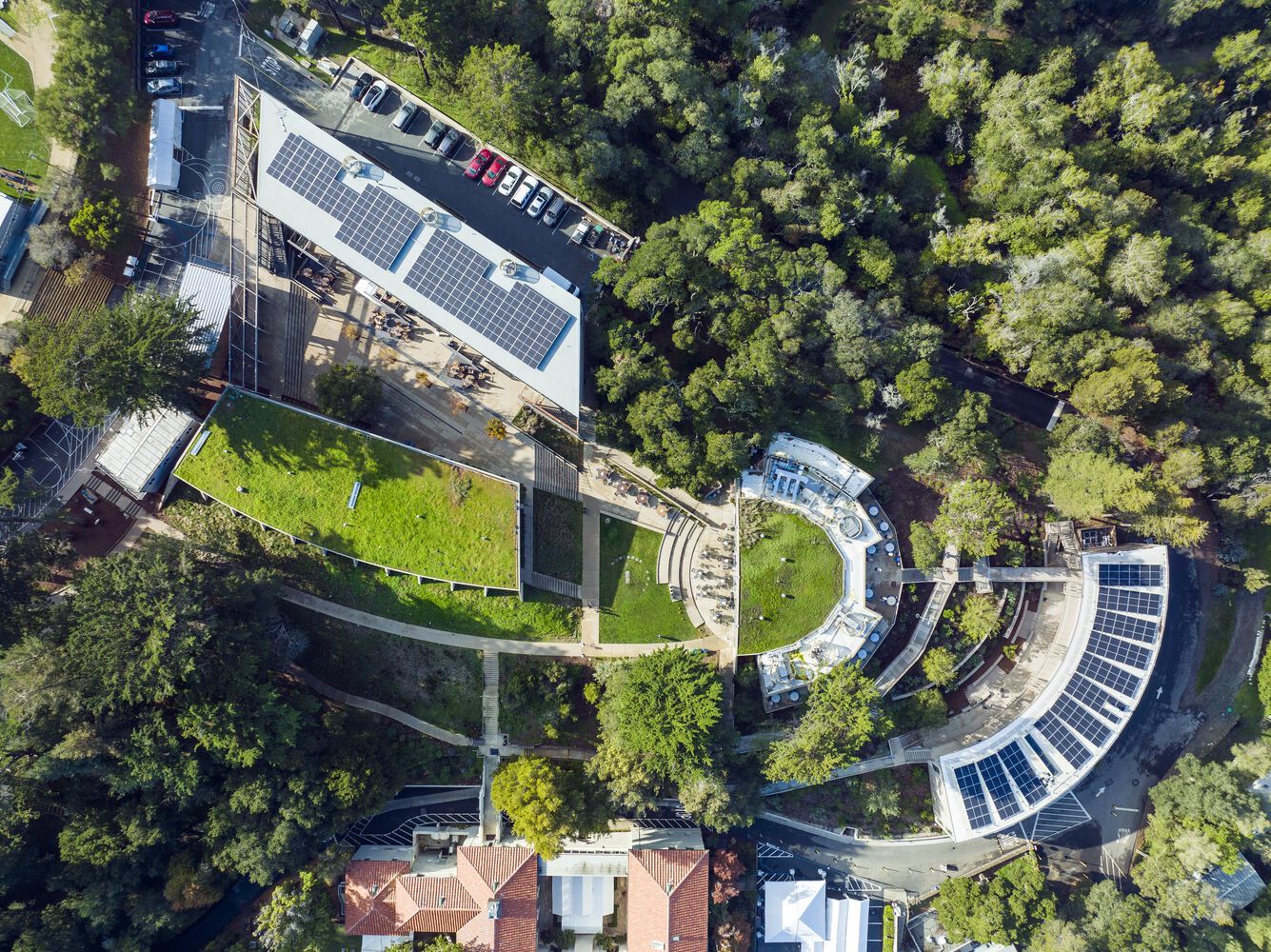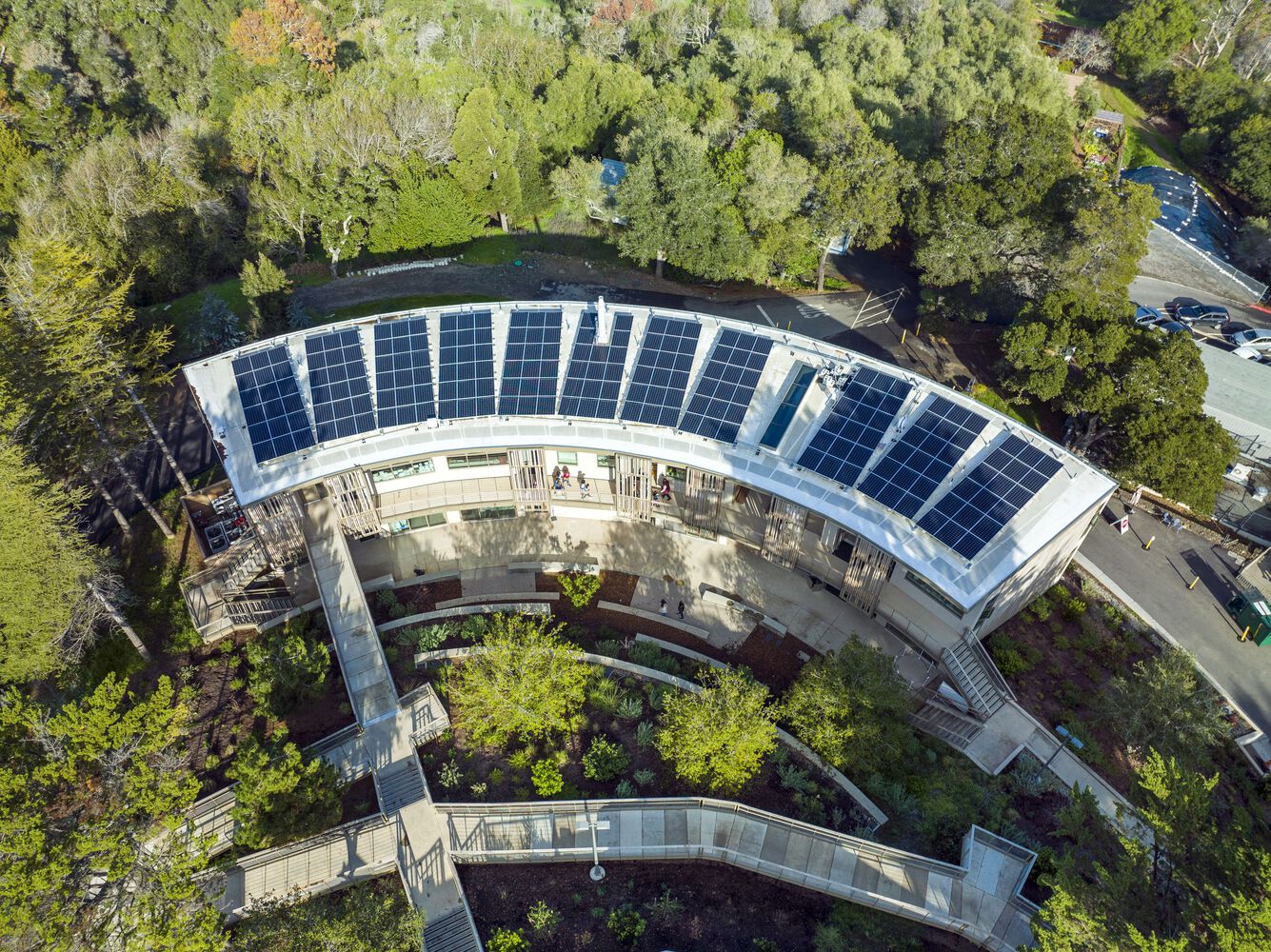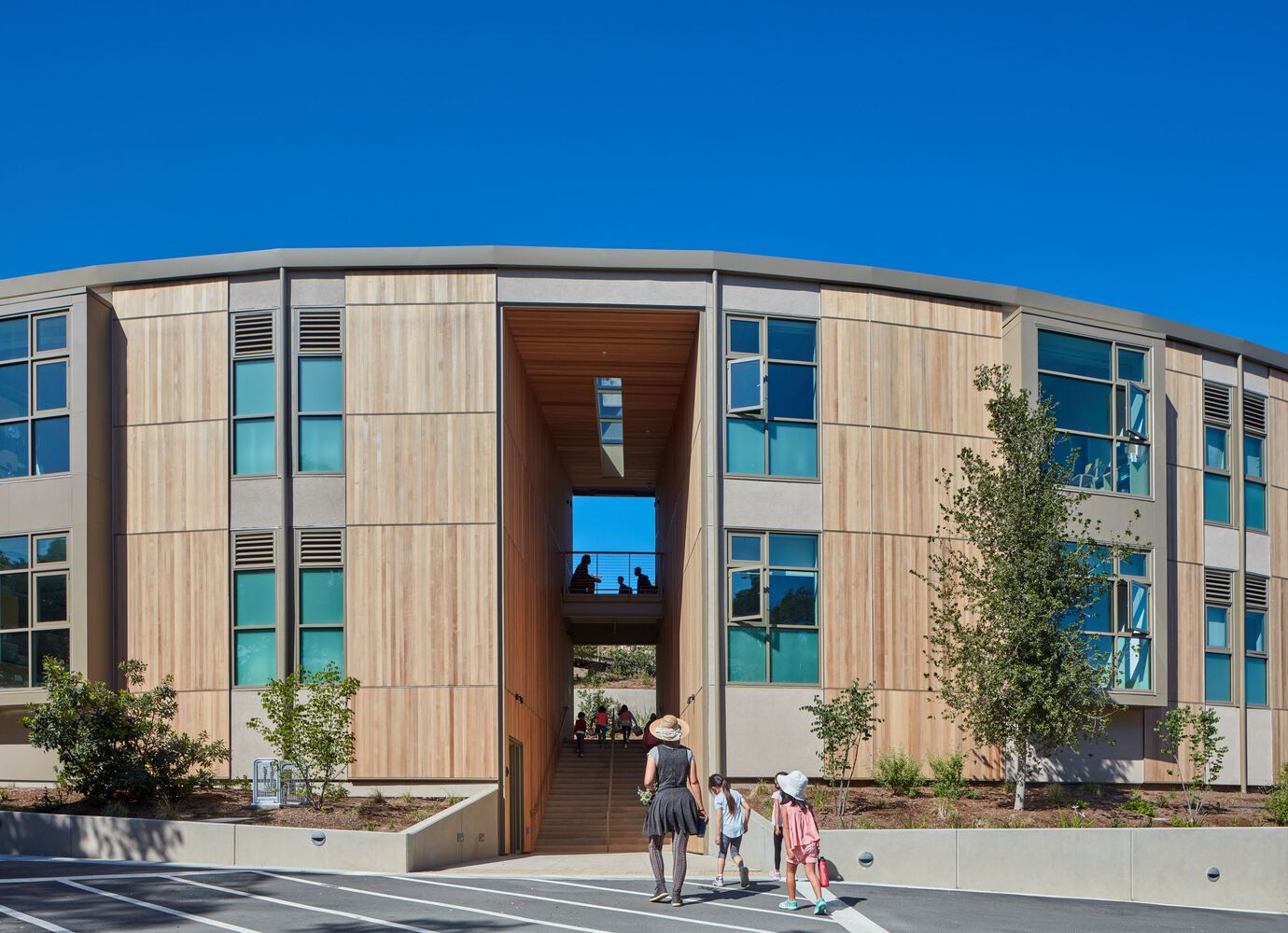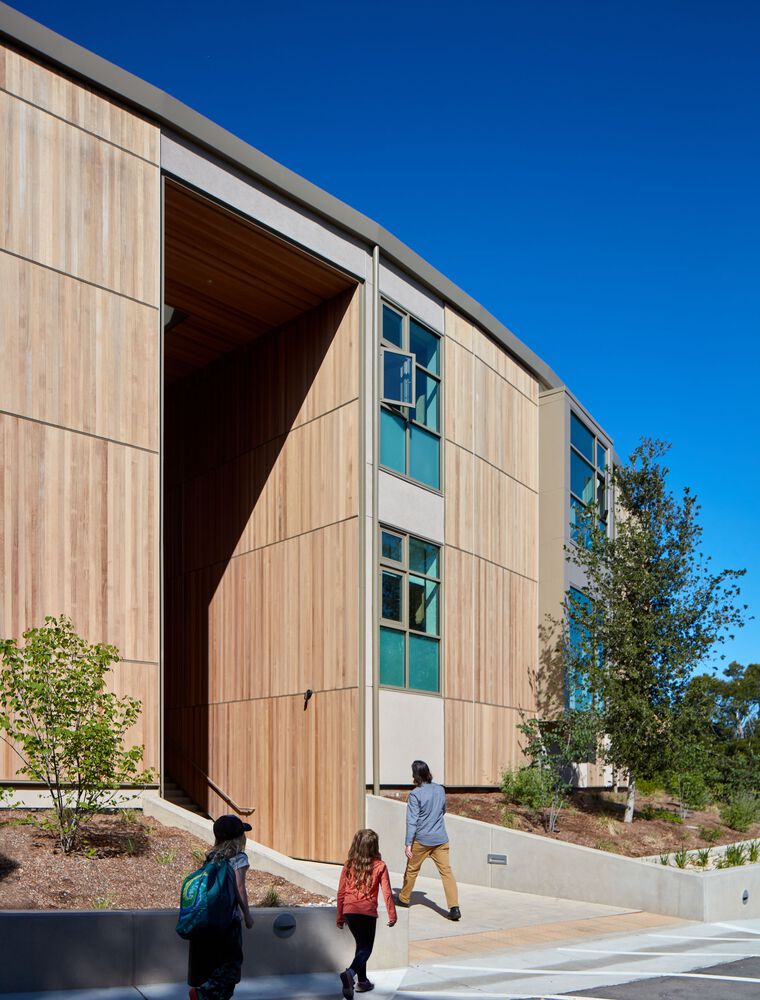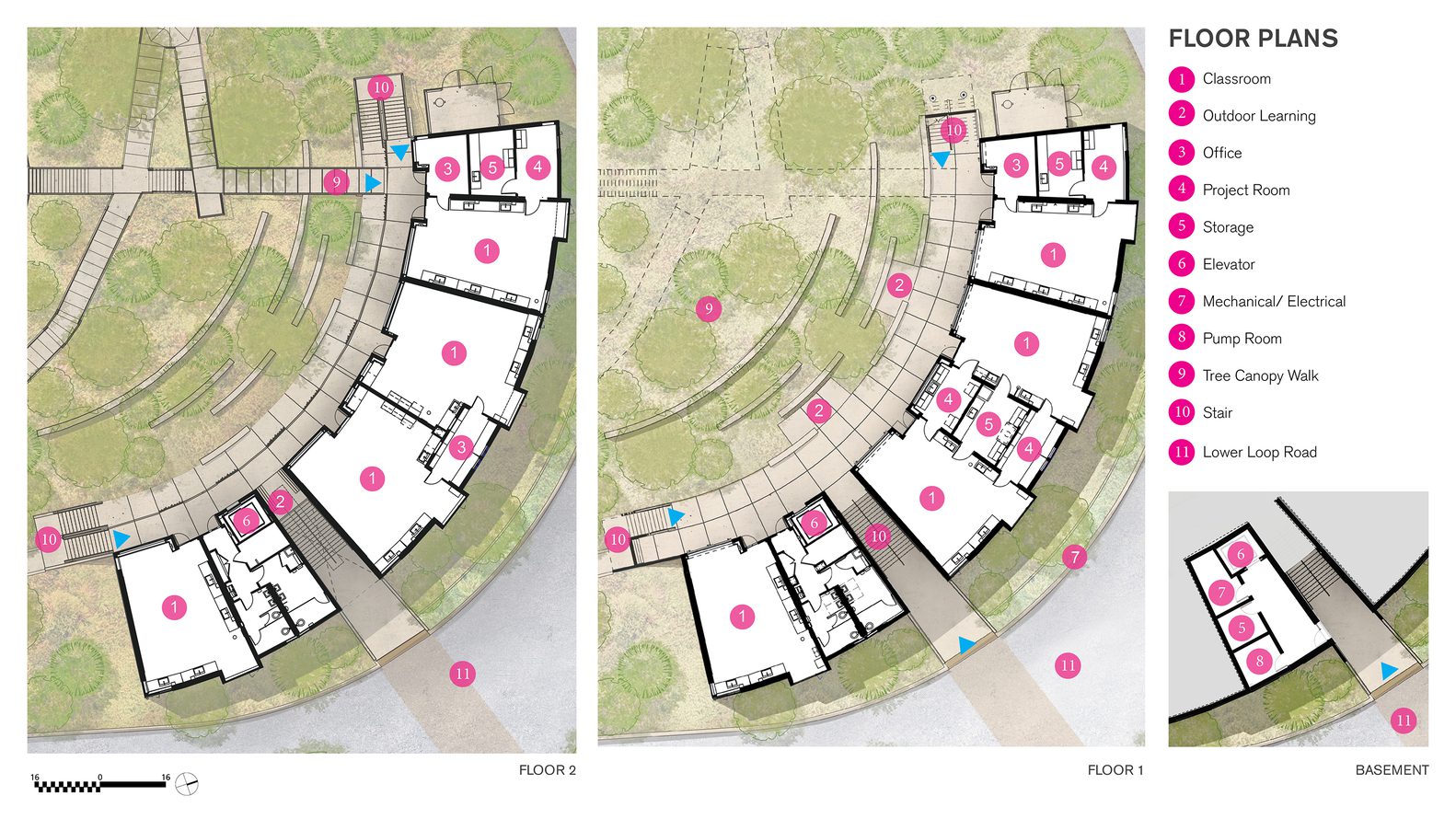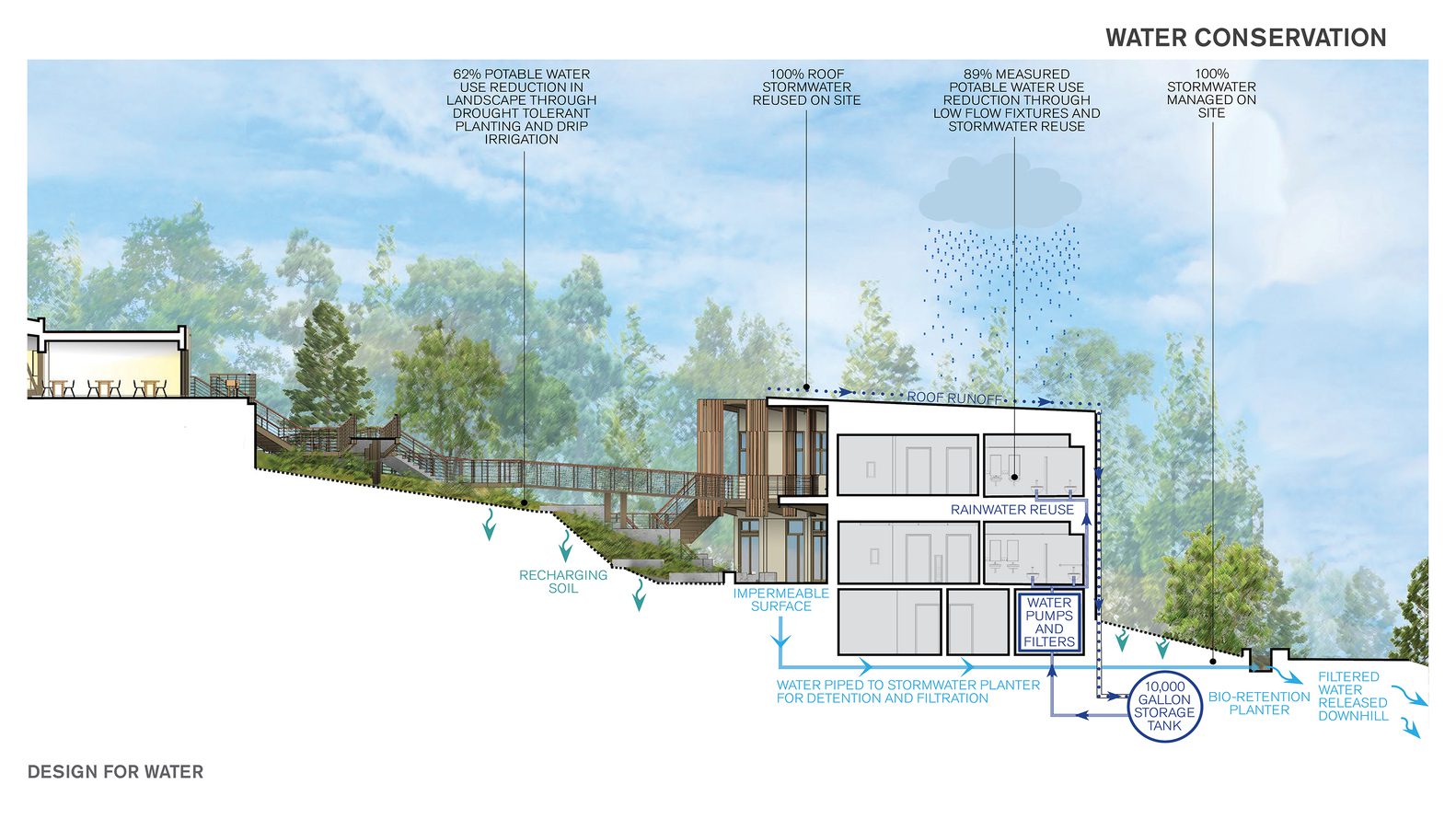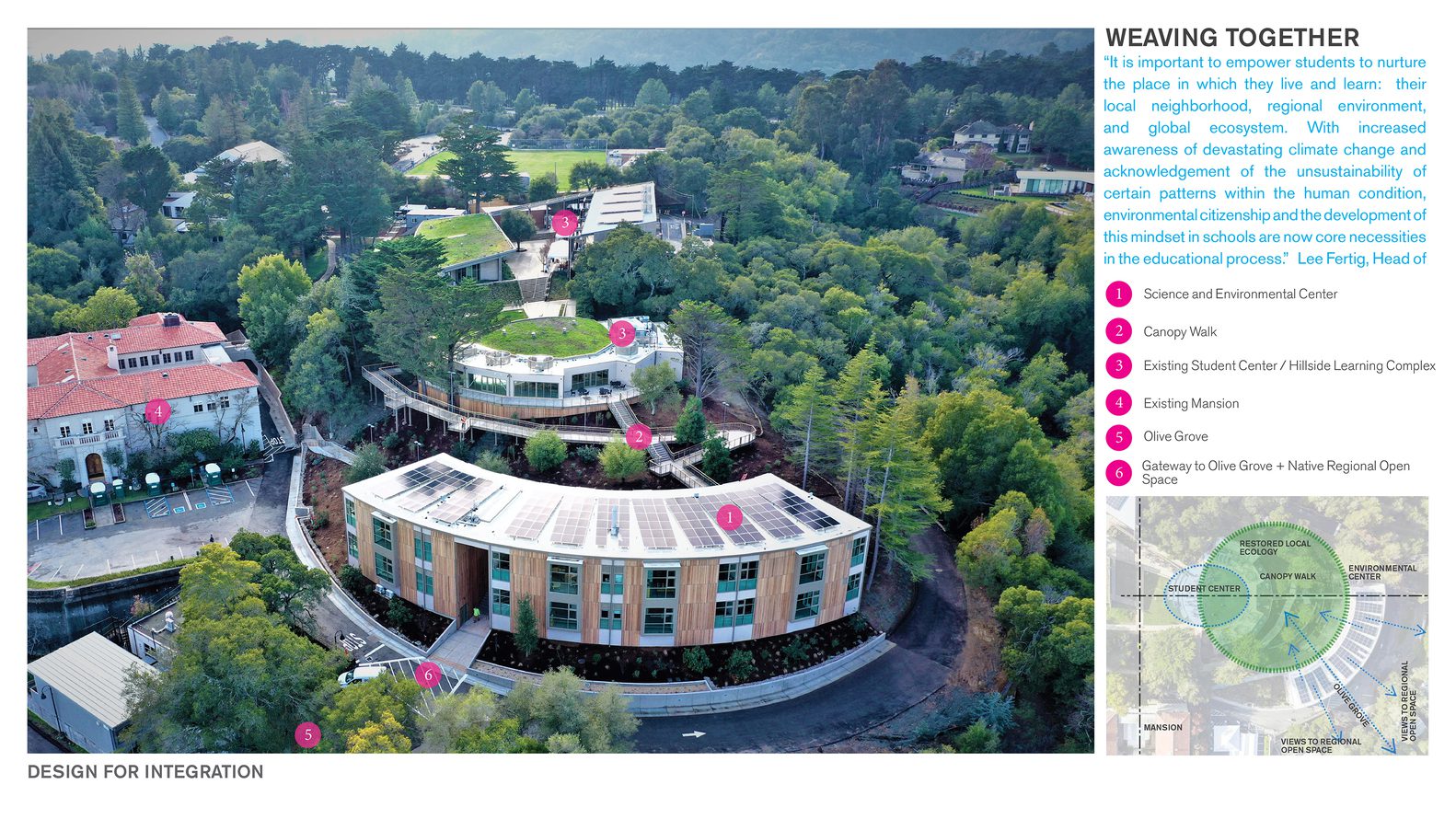The Science and Environmental Center embodies the Nueva School’s mission to inspire passion for lifelong learning, foster social acuity and environmental citizenship, and develop the child’s imaginative mind, enabling students to learn how to make choices that will benefit the world. Founded in 1967, the Nueva School is an independent school, with the Hillsborough campus serving over 500 students from pre-kindergarten to eighth grade. The 33-acre campus, located in the semi-rural coastal hills of the San Francisco Peninsula, features a thriving coastal live oak woodland ecosystem, a variety of dispersed structures and dramatic views of San Francisco Bay. The Science and Environmental Center is the final phase of the earlier Nueva Hillside Learning Complex originally completed in 2008. “It is important to empower students to nurture the place in which they live and learn: their local neighborhood, regional environment, and global ecosystem. With increased awareness of devasting climate change and acknowledgment of the unsustainability of certain patterns within the human condition, environmental citizenship and the development of this mindset in schools are now core necessities in the educational process.” – Lee Fertig, Head of School
Ecology of Learning – The new Science and Environmental Center supports the school’s evolving mission of sustainability and environmental stewardship as a foundational pillar of student education. The project supports the school’s environmental citizenship program with eight science labs and associated support spaces that bring together pre-kindergarten through eighth-grade classes to explore the interconnectedness of humans and the natural environment. Linked indoor and outdoor learning spaces serve as a living lab, where students practice sustainability, conduct environmental and social studies, and debate solutions to a broad range of environmental challenges.
Buildings that Teach – The Science and Environmental Center project teaches environmental stewardship, demonstrating how human interventions can be sensitive to the local environment and support regional ecologies. The project carefully weaves multiple sustainable strategies together, connecting school culture to place, and creating education spaces that inspire lifelong learners while showing reverence for the natural world. The building is 100% electric and designed to be net zero operational energy/carbon, producing on-site all the energy it consumes annually. Its narrow floor plate allows for ample daylighting, views and natural ventilation, demonstrating how passive natural systems can reduce our need for energy. In an era of more frequent and severe droughts, the building promotes advanced water conservation by harvesting rainwater in a 10,000-gallon storage tank for reuse in the building’s toilets, reducing potable water use by 89% compared to the baseline. The Science and Environmental Center is a threshold building, visually and physically connecting the built campus with the forested regional open space beyond. A “Canopy Walk” links the existing Student Center at the heart of the campus to the new Environmental Center with a universally accessible educational path across the steep site. By using the Canopy Walk, all students—regardless of physical ability—may experience and explore the seasonal rhythms of the restored oak woodland ecology.
Process – In 2012, the Nueva School embarked on an update to its campus master plan. They held a series of workshops with the Nueva School community, including students, staff, faculty, parents, alumni, and Hillsborough neighbors to identify campus opportunities, constraints, needed facility improvements, and evolving programmatic needs, which included: advance Nueva School’s leadership in environmental education; provide a new home for the school’s re-conceptualized PreK- 8 environmental education program; demonstrate innovative solutions for energy and water conservation on campus; provide for a resilient and regenerative Nueva Community; continue to serve the community and the biosphere; preserve open space on campus by concentrating new construction to areas already impacted; preserve the native ecology of the site by limiting grading, tree removal, and landscape disturbance; and improve Nueva School’s ability to advance educational reform with updated facilities to support conferences, teacher training institutes, after school programs, and summer education programs as the school’s outreach program commits to improving education delivery to students beyond the campus. During this process, a new Environmental Center building was identified to provide “. . . flexible classroom space for the investigation of natural ecologies of the Nueva campus and beyond. Located at the trailhead to Crocker Road hiking trails, this building is a threshold for the investigation of the natural environment and will be a vital piece of the environmental sciences curriculum.” The final program, building size, and location of the Environmental Center were finalized in 2015. The 11,600 SF building includes eight flexible environmental science classrooms with exterior learning spaces that support interdisciplinary learning. To meet the specific goals of the masterplan the project was designed for: Carbon Reduction: All electric building; zero net energy / zero net carbon; Water Conservation: Reduce potable water use in the building by at least 70%; Habitat Preservation and Restoration: Preserve and enhance access to campus and regional open space; Resiliency: Provide flexible and adaptable educational environments that support evolving pedagogies and expanding community outreach programs in earthquake and wildfire safe construction. The Science and Environmental Center is central to the school’s environmental citizenship program that was launched in 2019, supporting the school’s mission by providing innovative educational environments that promote strong community, interdisciplinary interaction, lifelong learning, and environmental stewardship. In recognition of the school’s exemplary achievement and practice in resource efficiency, health and wellness, and environmental and sustainable education, The Nueva School was named a National Green Ribbon School by the US Department of Education in April 2021.
Weaving Together – The design integrates straightforward, appropriate, and cost-effective sustainable design solutions that provide practical and poetic connections between people and the natural world. The building shape echoes the landform, following the topography of the hillside to minimize excavation and maximize outdoor education space that extends ground floor classrooms. The narrow floor plate minimizes impacts to the existing natural features of the site while maximizing daylighting and natural ventilation within the classrooms—two passive strategies that connect students to the seasonal rhythms of the site while reducing energy loads in the building. The Canopy Walk provides a universally accessible journey through the forest that connects the new Environmental Center with the existing Hillside Learning Complex. The previously disturbed landscape in this area was restored to an oak woodland habitat with native and adapted planting to promote biodiversity. This heightened beauty and presence of the native ecology further grounds us to place, reminding students and visitors of the active role we must take in conservation and stewardship. The project includes eight classrooms and support spaces that provide a variety of innovative educational environments that connect students and faculty to the world around them, promoting environmental stewardship and lifelong learning daily. Through a variety of simple, observable systems and strategies, the project is designed to be zero net energy/zero net carbon—an all-electric building that models a resilient, low-carbon future. Energy-efficient building systems combined with a high-performance building envelope reduce building EUI to 23, a 71% reduction from baseline. A 70kw photovoltaic array located on the roof of the building provides energy production to offset the building’s anticipated annual energy use. As climate change continues to impact California’s potable water supply, the project takes an active role in reducing potable water use by 89% below baseline.
Equitable Experience – The Science and Environmental Center is central to the school’s environmental citizenship program, so it was paramount that the building be welcoming to all students and community members. The Canopy Walk was developed to connect the new building directly with the Student Center and the heart of the campus, inviting everyone to share the experience of gliding through the restored native ecology of the site. A series of ramps meeting stringent universal design requirements hover above the landscape, offering expanded landings to linger, whether stopping to talk with a fellow student or writing a poem inspired by the smell of spring blossoms. The experience of nature along the Canopy Walk reinforces the biophilic connection we all share to the land, its vibrant ecology, and to vistas of the region beyond. This experience serves as both a sensory introduction and a transition to the more focused environmental studies that take place at the Science and Environmental Center. It’s an experience that speaks to our common humanity.
Design Intent – As a “private school with a public purpose,” the Nueva School and this building specifically serve both their academic community and the broader community. It supports and celebrates shared natural open space and native ecologies; it welcomes and provides financial aid to a diverse student body from throughout the region; and it serves as an educational model regionally and nationally, hosting summer camps, frequent educator conferences and workshops, and other events that advance the role of ecological design thinking in 21st-century education. A series of workshops were held with various stakeholder groups including students, staff, faculty, parents, alumni, and residential neighbors. The discussions and outcomes of the workshops were documented in written form and shared at subsequent meetings. As the design for the project developed, the school continued its outreach to various stakeholder groups with specific meetings targeting adjacent neighbors to build consensus for the project. When the town held public meetings to review and approve the project design, there was no opposition to the project, and it was unanimously approved. A central goal of the project was to preserve and enhance access to open space on the campus. The benefits of preservation extend beyond the project site to the greater community which benefits from the preservation of native flora and fauna that support migratory birds and other wildlife. Enhanced universal access to the open space allows for all community members regardless of their ability to experience the seasonal rhythms of the native ecology. The project team preserved open space by reducing the building footprint, conforming to existing topography, and selecting a previously disturbed site. Exterior circulation along the building is cantilevered from the structure, minimizing the foundation work and disturbance to existing open space. Similarly, the Canopy Walk is supported by single columns that allow the native planting and site drainage to continue beneath the elevated path. The existing open space adjacent to the building was regenerated with the planting of new oak trees and other native understory plants that support local biodiversity. The Canopy Walk has developed into the main circulation path to access the Environmental Center. It is a celebratory walk through the restored forest canopy that is experienced by all students as part of their daily movement across the campus. The Canopy Walk also supports universal access to the greater community who participate in conferences, summer camps, and other community events hosted by the school. Embracing the idea of universal access early in the design process, we explored options for providing a direct, accessible path from the existing campus development to the new building. Due to the significant vertical grade change between the new and existing buildings, we developed the Canopy Walk that extends from the Student Center ground floor to the second floor of the Environmental Center. An elevator accessed from the exterior of the building provides a vertical connection down to the first floor and basement, which provides access to the adjacent forest and open space preserve.
Design for Ecosystems – The project is located on the San Francisco Peninsula, an area defined by a Mediterranean climate with vegetation zones that include Chaparral, Coastal Scrub, Coastal Oak Forest, and Grassland. The project touches the land lightly and pursues a landscaping strategy that promotes biodiversity, incorporates carbon sequestration, and reinforces an immersive, visceral experience of the rhythms of the natural world. The project’s elevated Canopy Walk serves as a transition from the main campus and an introduction to the restored and protected natural ecosystem. Upon arrival, the new building is experienced as both a literal and figurative threshold to the natural world -carefully woven into the land, following the arc of the land across a ridge line, and integrated with the natural topography to minimize its impact on the natural setting. Restored native habitat equals 400% of the building footprint. Building materials and colors derive from the native materials of the site, reinforcing an intuitive connection to the land. These strategies combine to link daily experience to the drama of the hillside, the native ecology, and dramatic views of the Bay beyond, connecting students to the multivalent layers of their environment. All new planting complements the existing native trees to expand and diversify the hardwood forest canopy and compliment it with an understory of native shrubs and ground cover, consistent with the local floral-faunal complex. The project occupies a steep hillside, where the stability of the slopes and slowing of rain-water run-off is paramount. Soil preservation and dense planting contribute to this goal.
Water – Located in a semi-arid climate that experiences increasingly frequent and severe droughts, the project mitigates the impacts of stormwater drainage and reduces potable water use in the building by over 89%. Water-saving fixtures along with a stormwater reuse system were designed to reduce potable water consumption by 70% from baseline. The measured potable water use for the building in 2021 was an 89% reduction of potable water use compared to the baseline. Draught-tolerant native landscaping and drip irrigation systems reduce landscape water use by 62% from baseline. Irrigation water use was optimized in the design by accommodating hydro zones and climate exposure. By locating the new building around a natural ridge, the project minimizes disturbance of natural drainage patterns. A Storm Water Management Plan reduces site drainage to a practical minimum given the high clay content of native soils and steep slopes. Stormwater from the roof of the Environmental Center is collected in a 10,000-gallon underground storage tank for re-use in the building toilets, further reducing reliance upon potable water. Stormwater that is not re-used in the building is captured, conveyed to and treated by the on-site bio-retention treatment basins. The treatment basins remove 80% of total suspended solids from the water before it is discharged off-site. The project promotes regional potable water supply resiliency by reducing building potable water use by 89% in 2021. Capturing stormwater from the building roof for reuse in toilets plays a critical role in potable water use reduction as the stormwater reuse system was designed to provide over half of the building’s water needs. With permeable surfaces and dense planting, stormwater run-off is minimized, detained, and bio-filtered, preserving water quality in the seasonal streams that drain into San Francisco Bay. The project’s potable water conservation strategy includes; Fixtures: Ultra low-flow fixtures are utilized throughout the project, with the toilets being connected to a stormwater reuse system; Irrigation: Drought tolerant planting and drip irrigation are used throughout the project; Mechanical systems: No potable water is used in mechanical systems; Process systems: No potable water is used in process systems.
Building Efficiency – The building was designed as a simple structure to minimize conditioned area, maximize plan, structure and skin efficiencies, and reduce material use. The exterior stairs and corridors reduce wall area and conditioned space. The net-to-gross floor area ratio is 95%, extremely efficient for a school building. The building mass is minimally articulated, resulting in simple, highly efficient structural systems and reduced surface area. Wherever possible, structural systems are left exposed as finish material. More with Less. The exterior circulation allows the classrooms to have windows at each side of the room, maximizing daylighting and natural ventilation -two passive systems that reduce energy loads and operation costs in the building. Ceiling fans are provided to further promote air circulation and increase occupant thermal comfort. This strategy allowed for mechanical cooling and associated costs to be eliminated from the project. The exterior circulation on the second floor also acts as a sunshade blocking daylight from entering the classrooms in warmer late spring and summer afternoons. A low window/wall ratio of 13% maximizes daylight, views, and natural ventilation for the classrooms while providing an energy-efficient exterior envelope that reduces thermal bridging and conserves interior thermal comfort. To minimize building footprint and foundation costs, the project efficiently fits two stories within the 32-foot height limit required by the local planning code. A series of faceted plans allow for a simple steel structure to form the overall curvilinear form of the building that follows the topography of the hillside.
Design for Energy – To reduce both dependences on fossil fuels and carbon dioxide emissions, the Science and Environmental Center incorporates all-electric building systems and is designed to be zero net energy/zero net carbon. Design strategies include Passive Systems: The linear form of the building allows for classrooms to have ample access to daylight and natural ventilation, reducing the energy loads associated with lighting and mechanical cooling. Active Systems: An all-electric heat pump system provides in-floor radiant hydronic heating to all spaces. With the addition of ceiling fans to promote air circulation and natural ventilation, mechanical cooling was eliminated from the project. Energy recovery ventilators provide 100% outside air when the classrooms are occupied. System controls are straightforward and appropriate to the simple conditioning strategies employed. LED lighting reduces overall lighting power density by 49%. Energy Conservation: A high-performance exterior building envelope reduces thermal bridging and provides significant R values at the roof and walls to conserve interior thermal comfort. Energy-efficient building systems combined with a high-performance building envelope reduce building EUI to 23, a 71% reduction from baseline. On-site Renewable Energy: A 70 KW photovoltaic array is located on the roof of the building to offset the building’s energy use over the year. The design focused on maximizing the onsite renewable energy potential of the photovoltaic array. This included extensive studies on ways to minimize the impacts of shadowing from adjacent mature trees. A highly efficient panel along with optimizers was incorporated into the final design with an anticipated annual energy production of 80,200 kWh. The measured onsite energy production for 2021 was 93,941 kWh, an increase of 17% above the anticipated production. Exterior wall design includes standard metal stud framing with batt insulation overlayed with 1” exterior insulation to reduce thermal bridging and increase overall assembly to R-24; roof design includes R-38 batt insulation overlayed with 2” of rigid insulation to increase overall assembly to R-50; glazing properties include 0.28 U-value, 0.27 SHGC, and 0.65 VLT.
Design for Well-Being – The design promotes a healthy learning community and individual well-being, emphasizing simple solutions that maximize user comfort, social engagement, and connections to nature while reducing first cost and long-term maintenance. 100% of the regularly occupied spaces have access to operable windows, natural daylighting, and views out to nature. Material selection, including no-VOC paints and adhesives, formaldehyde-free materials, and linoleum flooring, combined with 100% fresh air mechanical ventilation ensures healthy indoor air quality. All classrooms incorporate high NRC-rated acoustical ceiling materials to absorb sound and cushioned linoleum flooring to reduce footfall reverberation. Exterior stairs and ramps are centrally located to encourage active vertical circulation around the building and adjacent site. Due to the open-air circulation and excellent access to natural ventilation, the building has proven to be easily adapted to the health requirements of the COVID pandemic, however, the pandemic has also delayed post-occupancy evaluation. Building Resources. Building materials were selected for economy, durability, and resource efficiency. The overall shape of the building models’ resource efficiency through simple building forms that rely on an efficient structural steel system to provide long-term durability. Acknowledging that ecological conservation and social responsibility extend beyond the project site, 100% of the interior and exterior wood is FSC-certified from responsibly managed forests on the West Coast. 15% of building materials are made from recycled materials, including steel, concrete, cotton insulation, and aluminum. During construction, 89% of site and construction debris was recycled and diverted from landfills.
Design for Change – The building was designed to provide flexibility and adaptability in both short and long terms. In the short term, teaching spaces are easily adaptable to evolving curricula and technologies. Overhead electrical cord reels in each classroom accommodate a variety of desk configurations. The simple building plan was generalized to the greatest extent possible, allowing for future adaptation to alternative uses in the long term, including housing if needed. In response to climate change, the heat pumps can be easily adapted to run in cooling mode to provide cooling to the classrooms as temperatures rise. The fresh air ventilation system has filters that can be easily replaced with HEPA filters when air quality is poor due to more frequent wildfires. Construction was underway in 2020 when the COVID pandemic unfolded and schools across the country shifted to remote learning. The Nueva School, recognizing the negative social impacts of remote learning, adapted the Science and Environmental Center to accommodate in-person learning in January 2021. Outdoor education spaces became extensions of the classrooms, allowing students to spread outdoors while maintaining visual connection with teachers. The outdoor spaces also provided simple recreation and lunch activities for students to use. The project is located in a wildland-urban interface zone, so the design incorporated design strategies to harden the building against damage, including non-combustible concrete and steel construction, a fire sprinkler system, and 1-hour fire-rated exterior skin assemblies. The school voluntarily upgraded the project to meet the strictest seismic design requirements, providing for long-term resiliency after a significant earthquake.
Project Info:
-
Architects: Leddy Maytum Stacy Architects
- Country: Hillsborough, United States
-
Photographs: Richard Barnes, Bruce Damonte
-
Manufacturers: Sherwin-Williams, AO Smith, American Standard, Sloan, Armstrong, B-K Lighting, Ceco Door, Daltile, Durcon, Inc, EFCO, Finelite, Forbo, ICI Scientific, LCN, Masonite Architectural, Otis, Schlage
-
Civil Engineer: BKF Engineers
-
Structural: Murphy Burr Curry
-
MEP: Point Energy Innovation
-
Electrical: Cupertino
-
Landscape: CMG Landscape Architecture
-
General Contractor: WL Butler


